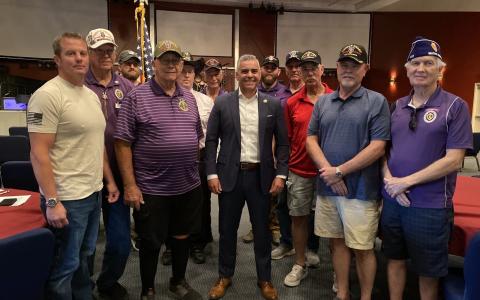Ciscomani Leads Effort to Increase Flexibility for Purple Heart Recipients
WASHINGTON, D.C. - Congressman Juan Ciscomani is leading a bipartisan effort to get the U.S. Army to review regulations that prevent eligible veterans and service members from receiving one of our nation’s most distinguished military honors, the Purple Heart.
A Purple Heart is given to current and former members of the Armed Forces who’ve been wounded or killed as a result of enemy action while serving. But a gap in the regulations has barred thousands from receiving the honor, including at least one in Ciscomani’s 6th Congressional District.

Ciscomani meets with the Military Order of the Purple Heart
“It simply isn’t fair,” said Ciscomani, a member of the House Veterans’ Affairs Committee. “I’ve personally met an Iraq War veteran who nearly gave his life serving our country and is prevented from even being considered for a Purple Heart because of regulations that may not reflect the realities of combat. This is wrong and it needs to change.”
Ciscomani and nine other members of Congress are urging Secretary of the Army Daniel Driscoll to review the regulations to provide greater flexibility when considering Purple Heart applications.
In a March 28 letter to Driscoll, the lawmakers wrote that veterans and service members who’ve been diagnosed with traumatic brain injuries have been denied a Purple Heart because they lack proper documentation.
The lawmakers wrote, “While we recognize the difficulty in establishing clear guidelines for every combat scenario, greater flexibility is urgently needed. The Army’s appeals process, which we fully support, can take over a year to resolve—an unacceptably long wait for veterans seeking proper recognition of their injuries.”
The Purple Heart is the oldest military award presented to American service members. It bears the likeness of President George Washington, who first presented an early version of the award in 1782. It was redesigned in 1932 at the direction of Gen. Douglas MacArthur.
According to Army Regulation 600-8-22, a Purple Heart can be presented to an individual who suffered a wound, injury, or death as a result of enemy or hostile act, international terrorist attack, or friendly fire. The individual must have also received treatment by medical officials and have official records of medical treatment. Unfortunately, that last requirement does not account for situations where a medical officer may not be present to provide treatment.
Joining Ciscomani in signing the letter are Jeff Hurd (R-CO), Brian Fitzpatrick (R-PA), Pat Fallon (R-TX), Diana Harshbarger (R-TN), Don Davis (D-NC), Jen Kiggans (R-VA), Scott Peters (D-CA), Tony Gonzales (R-TX), and Mike Haridopolos (R-FL).
The full text of the letter can be viewed here and below:
Dear Sec. Driscoll:
We are writing to express our concern regarding current Army regulations that are inhibiting veterans and service members nationwide from receiving proper consideration for a Purple Heart decoration from the United States Army. As you know, this honor is awarded to those who have sacrificed greatly in defense of our country and our freedoms, and therefore we take great care to ensure its proper consideration.
Specifically, we have concerns with Army Regulation 600-8-22, which governs the eligibility criteria to award the Purple Heart to individuals injured in the line of duty and its related impact on service members who were unable to be treated by a medical officer at the time of their injury. We have met with those whose vehicles were struck by IEDs or exposed to concussive blasts, resulting in diagnosed traumatic brain injury (TBI), and despite following the proper channels, their applications for a Purple Heart have been denied due to a lack of contemporaneous documentation, often through no fault of their own.
The regulation requires that each approved award of the Purple Heart must meet the following requirements: a) a wound, injury, or death as a result of enemy or hostile act, international terrorist attack, or friendly fire and b) treatment by medical officials and official records of said medical treatment. Unfortunately, the latter requirement does not account for the realities of combat, particularly in incidents where a medical officer may not have been present to provide treatment. Oftentimes, soldiers stationed at forward operating bases with limited medical capabilities may not receive treatment until they return to base or redeploy.
Further, in some cases service members are unaware that they need referrals for TBI treatment documented in their health records, creating significant barriers when applying for a Purple Heart. The nature of blast injuries means that symptoms do not always manifest immediately, making it even more difficult to obtain proper documentation at the time of the incident. Yet, these injuries have long-term consequences, affecting not only the individual’s health but also their ability to access care and benefits after service.
Additionally, other Army processes—such as referral to the Physical Evaluation Board (PEB)—or external entities like the VA have documented TBI diagnoses as a result of combat, medical retirements, and evidence of referrals for treatment for a veteran or service member, but the Department of the Army does not allow for the consideration of these forms of record. We believe that this evidence should be considered when determining initial Purple Heart eligibility, and yet they are often overlooked.
While we recognize the difficulty in establishing clear guidelines for every combat scenario, greater flexibility is urgently needed. The Army’s appeals process, which we fully support, can take over a year to resolve—an unacceptably long wait for veterans seeking proper recognition of their injuries. During this time, many of these veterans are left in limbo, waiting for decisions that impact not only their recognition of service but also their long-term well-being. Our offices stand ready to assist in expediting these appeals and advocating for regulatory adjustments to reduce unnecessary delays.
We urge you to review these regulations with partners in the Department of Veterans Affairs and look forward to your timely reply on how we can partner to move this process forward.
###